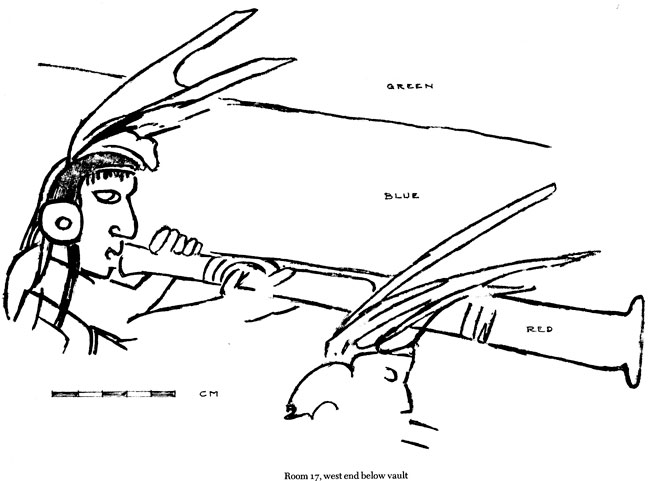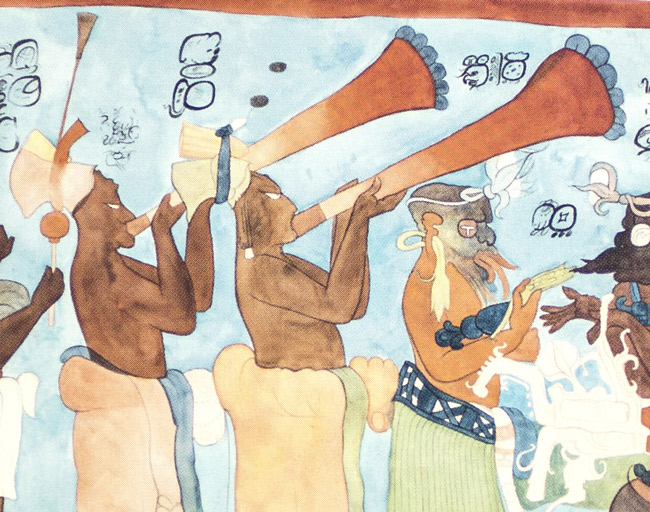Maya battles were initiated with trumpets blasting
IMS has been providing public education for 47+ years, via their own members and invited professors from around the Americas.
The murals of Bonampak put Mayan musical instruments into every article, book, and web page written about the music of the Classic Maya. I was at Bonampak in front of these murals at age 17, in 1962, flown into a Lacandon area airstrip courtesy of the INAH team who were going to Bonampak to set up their camp. By coincidence I was in the same hotel as they were (in Tenosique, Tabasco, Mexico) and when I heard them talking about Bonampak I went over to introduce myself and ask if I could help them set up camp (and assist in carrying equipment from the airstrip up and down the hills and across the creeks (no airstrip at Bonampak itself in those days).
Then came Mary Miller’s two gorgeously illustrated books on the Bonampak murals (plus multiple articles by dozens of scholars on the instruments you see in these murals).
The team at FLAAR Mesoamerica in Guatemala and FLAAR in USA is inspired to accomplish fresh additional research on Mayan musical instruments. And, for the trumpet, to distinguish between trumpet for blasting a clear signal that your warriors were ready to attach or defend; and using a trumpet for a ceremonial performance to create emotional music.
Last week (late October, 2020), linguist David Bolles kindly sent me a book by his father, architect/archaeologist John Bolles. In the book was a sketch of a Chichen Itza trumpet player that inspired me to write this introductory web page.
Mayan trumpet in a mural at Chichen Itza, Las Monjas
 |
Trumpet in use, in mural at Chichen Itza, Las Monjas, Room 17, sketch by architect John Bolles, working for the Carnegie Institution of Washington project. |
Trumpets in the murals of Bonampak
 |
Best place to see the murals of Bonampak are in books by INAH, UNAM, by Mary Miller, and the original earlier publications by the Carnegie Institution of Washington. |
Conch shells (seashells) are usually called trumpets
Conch shell trumpets are found in many museums. These are a “trade mark” of Classic Maya music. But our initial portion of our overall musical instruments research project is on instruments made from agave, wood, reeds (for flutes), etc. And this first page is on trumpets; later on reeds.
Small wind instruments of ceramics I would not classify as a trumpet. But depends on size, shape, and sound. Most trumpets were made from plants: tree limbs or agave or gourds. Depends on what plants are available in the mountains (the Maya Highlands) and what plants are available in the Maya Lowlands. Of course musical instruments would have been carried by merchants long distances. Tikal is nowhere near the sea yet conch shells would have been available to the musicians for every ruler or high priest at Tikal. So agave trumpets could have been brought in from the drier highlands (or planted in the royal gardens locally).
Many Maya trumpets were one material but at the end there was a separate aspect of a different material (potentially a gourd at the end of a wooden or agave trumpet). However the base of an agave trumpet is naturally wider and with a bulbous 20 or more centimeters (so nothing added).
Guaromo trees are called trumpet tree in Belize. Trumpet tree is used for species of the genus Cecropia and also for the significantly larger but poorly documented guarumo de montaña. Guarumo de montaña is a species of the genus Pourouma of the family Urticaceae (Magnoliophyta). Older botanists call it Pourouma bicolor.
The NYBG calls it Pourouma bicolor subsp. scobina (Benoist) C.C.Berg & Heusden. This tree occurs in Belize and adjacent Izabal and Alta Verapaz.
Since we are doing field work in Izabal (a 15 month project, Oct 2020 through all of 2021), we look forward to being the first archaeologist to find Pourouma bicolor and the first ethnobotanist in half a century to “rescue” this tree from oblivion.
Izabal is an unlikely area to find native agave, but nothing will surprise us, and we will be on the lookout; there are lots of agave plants along the highway from Guatemala City to Izabal area (especially in the Rio Motagua bosque seco corridor).
Mayan musicians use trumpets for processions and many other activities
Long trumpets and drums of various sizes and shapes are the musical instruments most frequently seen in murals and in palace scenes shown on ceramic vases. Although you might tend to correctly associate trumpets with “the call to war” the trumpets were also used for rituals and events.
Most YouTube videos of “Maya trumpets” being played are playing modern music. Only a few videos feature the literal noisy blast that would have been what the marching armies would have used these trumpets for. The soldiers did not play music; the soldiers blew the trumpets to scare the enemy.
Project to find all trees usable to make Mayan trumpets and Mayan drums
We (FLAAR, USA and FLAAR Mesoamerica, Guatemala) initiated a cooperative project coordinated with the Municipio de Livingston, Izabal, Guatemala this year. We are asking local people to assist us to find the tree that is reported as the source of trumpets of this size. As soon as we find this tree we will update this NEWS item.
Different trees (obviously much thicker) were used to make drums. This will be a separate NEWS item in November. Our team found these drums in use in the Municipio de Livingston and took photographs so you could see the size and shape of the tree part from which the drums were made.
So a lot to come on “how to make Maya musical instruments” from biodegradable and renewable resources.
First Posted October 30, 2020































